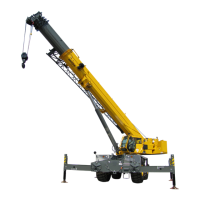SAFETY PRECAUTIONS 1300A OPERATOR’S MANUAL
2-8
Published 12-21-2011 CTRL #050-09
• Ensure the load lines are directly over the attach points
to avoid side loading and transfer of loading from one
crane to the other.
• Do not travel. Lift only from a stationary position.
ELECTROCUTION HAZARD
To avoid death or serious injury, keep all parts of the crane,
rigging and load at least 20 feet (6 meters) away from any
energized power line. You must follow the OSHA
requirements set forth in 29CFR 1926.1407 through
1926.1411.
This crane is not designed or equipped for use within 10 feet
(3 meters) of energized power lines [Refer to
29CFR1926.1410 Table A]. If operation within 10 feet (3
meters) of any power lines cannot be avoided, the power
utility must be notified and the power lines must be de-
energized and grounded before performing any work.
If contact is ever accidentally made with a power line and any
part of this crane, its rigging or load, never touch the crane or
even approach or come near the crane.
Electrocution can occur even without direct contact with the
crane.
Crane operation is dangerous when close to an energized
electrical power source. Exercise extreme caution and
prudent judgement. Operate slowly and cautiously when in
the vicinity of power lines.
Before operating this crane in the vicinity of electrical power
lines or equipment, notify the power utility company. Obtain
positive and absolute assurance that the power has been
turned off.
This crane is not insulated. Always consider all parts of the
load and the crane, including the wire rope, hoist cable,
pendant cables, and tag lines, as conductors. You, the
operator, are responsible for alerting all personnel of
dangers associated with electrical power lines and
equipment. Do not allow unnecessary personnel in the
vicinity of the crane while operating. Permit no one to lean
against or touch the crane. Permit no one, including riggers
and load handlers, to hold the load, load lines, tag lines, or
rigging gear.
If the load, wire rope, boom, or any portion of the crane
contacts or comes too close to an electrical power source,
everyone in, on, and around the crane can be seriously
injured or killed.
Most overhead power lines are not insulated. Treat all
overhead power lines as being energized unless you have
reliable information to the contrary from the utility company
or owner.
The rules in this Operator’s Manual must be followed at all
times, even if the electrical power lines or equipment have
been de-energized.
The safest way to avoid electrocution is to stay away from
electrical power lines and electrical power sources.
It is not always necessary to contact a power line or power
source to become electrocuted. Electricity, depending on
magnitude, can arc or jump to any part of the load, load line,
or crane boom if it comes too close to an electrical power
source. Low voltages can also be dangerous.
Reference Only

